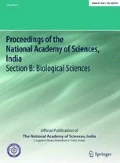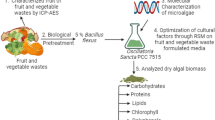Abstract
Beta-carotene, one of most widely known carotenoid molecules, is commercially used as food and feed additive, cosmetic and pharmaceutical products. The current study was aimed to evaluate the utilization of some agro-industrial wastes for β-carotene production by Rhodotorula glutinis yeast and optimization of the production process using Plackett–Burman design. Rice bran, sugarcane molasses and sugarcane bagasse were used in the production medium. Rice bran was the best low-cost substrate for biomass and β-carotene production of R. glutinis. Physical and nutritional parameters such as glucose, sucrose, yeast extract, NH4Cl, NaCl, MgSO4, KH2PO4, pH, inoculum size and agitation rate were screened using Plackett–Burman design to identify critical factors. Results of Plackett–Burman design suggest that sucrose, NaCl, KH2PO4 and pH were the most significant factors for β-carotene accumulation on rice bran. A quadratic model was constructed by response surface methodology—central composite design to study the impact of interaction and quadratic effect of these critical factors on β-carotene production. From predicted values obtained using quadratic equations, it was seen that the optimization to achieve maximum production of β-carotene was; sucrose 18.6 g/l, initial pH at 5.4, KH2PO4 1.01 g/l, NaCl 0.66 g/l to achieve a β-carotene content from 1.23 mg/kg rice bran to 3.20 mg/kg. As far as HPLC analysis is concerned, it clearly proved the presence of β-carotene which had 68.2% purity as compared with standard.


Similar content being viewed by others
References
Roadjanakamolson M, Suntornsuk W (2010) Production of β-carotene-enriched rice bran using solid-state fermentation of Rhodotorula glutinis. J Microbiol Biotechnol 20:525–531
Hernandez-Almanza A, Cesar Montanez J, Aguilar-Gonzalez MA, Martmez-Avila C, Rodriguez-Herrera R, Aguilar CN (2014) Rhodotorula glutinis as source of pigments and metabolites for food industry. Food Biosci 5:64–72
Silva C, Cabral JMS, Van Keulen F (2004) Isolation of a β-carotene over-producing soil bacterium, Sphingomonas sp. Biotechnol Lett 26:257–262
Couto SR, Gundín M, Lorenzo M, Sanromán MÁ (2002) Screening of supports and inducers for laccase production by Trametes versicolor in semi-solid-state conditions. Process Biochem 38:249–255
Rodríguez-Couto S, Rodríguez R, Gallego PP, Sanromán A (2003) Biodegradation of grape cluster stems and ligninolytic enzyme production by Phanerochaete chrysosporium during semi-solid-state cultivation. Acta Biotechnol 23:65–74
Economou ChN, Makri A, Aggelis G, Pavlou S, Vayenas DV (2010) Semi-solid state fermentation of sweet sorghum for the biotechnological production of single cell oil. Bioresour Technol 101:1385–1388
Holker U, Lenz J (2005) Solid-state fermentation—are there any biotechnological advantages? Curr Opin Microbiol 8:301–306
Vijayalakshmi G, Shobha B, Vanajakshi V, Divakar S, Manohar B (2001) Response surface methodology for optimization of growth parameters for the production of carotenoids by a mutant strain of Rhodotorula gracilis. Eur Food Res Technol 213:234–239
Buzzini P (2000) An optimization study of carotenoid production by Rhodotorula glutinis DBVPG 3853 from substrates containing concentrated rectified grape must as the sole carbohydrate source. J Ind Microbiol Biotechnol 24:41–45
Kupiec T (2004) Quality-control analytical methods: high-performance liquid chromatography. Int J Pharm Compd 8(3):223–227
El-Banna AA, EL-Razek A, EL-Mahdy AR (2012) Some factors affecting the production of carotenoids by Rhodotorula glutinis var. glutinis. Food Nutr Sci 3:64–71
Snedecor GW, Cochran WG (1989) Statistical methods, 8th edn. Iowa State University Press, Ames, p 503
Hart DJ, Scott KJ (1995) Development and evaluation of an HPLC method for the analysis of carotenoids in foods, and the measurement of the carotenoid content of vegetables and fruits commonly consumed in the UK. Food Chem 54:101–111
Pupin AM, Dennis MJ, Toledo MCF (1999) HPLC analysis of carotenoids in orange juice. Food Chem 64:269–275
Bhosale P, Gadre RV (2001) beta-Carotene production in sugarcane molasses by a Rhodotorula glutinis mutant. J Ind Microbiol Biotechnol 26:327–332
Malisorn C, Suntornsuk W (2008) Optimization of β-carotene production by Rhodotorula glutinis DM28 in fermented radish brine. Biores Technol 99:2281–2287
Shih CT, Hang YD (1996) Production of carotenoids by Rhodotorula rubra from sauerkraut brine. LWT Food Sci Technol 29:570–572
Chauhan B, Gupta R (2004) Application of statistical experimental design for optimization of alkaline protease production from Bacillus sp. RGR-14. Process Biochem 39:2115–2122
Le Man H, Behera SK, Park HS (2010) Optimization of operational parameters for ethanol production from Korean food waste leachate. Int J Environ Sci Technol 7:157–164
Thakur M, Azmi W (2014) Production of β-carotene by filamentous fungus Mucor azygosporus MTCC 414 in synthetic medium by applying response surface methodology. Ann Phytomed 3:93–100
Ferrao M, Garg S (2011) Studies on effect of media components on growth and β-carotene production by Rhodotorula graminis RC04. J Cell Tissue Res 11:2551–2556
Karnjanawipagul P, Nittayanuntawech W, Rojsanga P, Suntornsuk L (2010) Analysis of beta-carotene in carrot by spectrophotometry. Mahidol Univ J Pharmaceut Sci 37:8–16
Acknowledgements
The authors acknowledge the Department of Botany, Faculty of Women, and Cairo Microbial Resources Center (Cairo MIRCEN), Faculty of Agriculture, Ain Shams University for providing microbial strain and necessary research facilities.
Author information
Authors and Affiliations
Corresponding author
Ethics declarations
Conflict of interest
The authors declare that they have no conflict of interest regarding the publication of this research.
Additional information
Significance of the paper
Rice bran is a low-cost substrate of growth of Rhodotorula glutinis ATCC 4054 for β-carotene production. Statistical approach of the parameters in β-carotene production from R. glutinis ATCC 4054 generates a cheapest model with the highest yield. It was sucrose 18.6 g/l, initial pH at 5.4, KH2PO4 1.01 g/l, and NaCl 0.66 g/l.
Rights and permissions
About this article
Cite this article
Husseiny, S.M., Abdelhafez, A.A., Ali, A.AA. et al. Optimization of β-Carotene Production from Rhodotorula glutinis ATCC 4054 Growing on Agro-industrial Substrate Using Plackett–Burman Design. Proc. Natl. Acad. Sci., India, Sect. B Biol. Sci. 88, 1637–1646 (2018). https://doi.org/10.1007/s40011-017-0908-2
Received:
Revised:
Accepted:
Published:
Issue Date:
DOI: https://doi.org/10.1007/s40011-017-0908-2




